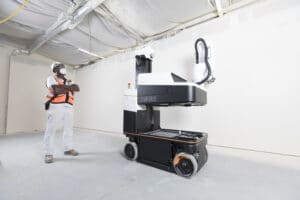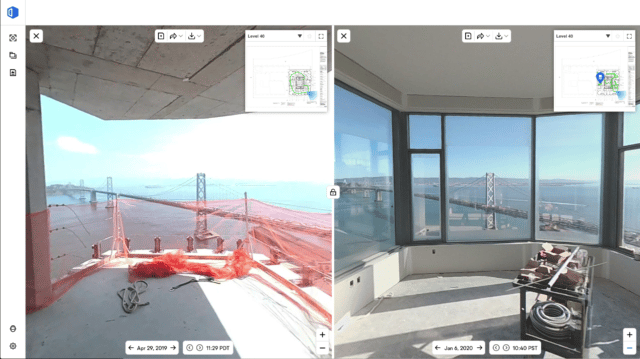
Suffolk-backed robotics startup Canvas designed a drywall finishing device that can cut project timelines up to 250 percent. Photo courtesy of Canvas
While robotics transforms the workings of factories and warehouses, construction projects unfold much as they have for decades, pointing to missed opportunities to save time and money.
Through its Suffolk Technology arm, Boston-based construction giant Suffolk is on the lookout for promising startups developing products that can speed up commercial project schedules. At a recent “Shark Tank”–style competition, one of the standouts was Canvas, a San Francisco company that’s developed a robotic drywall finishing machine that has been piloted on dozens of projects in the Bay Area.
The change is similar to replacing a shovel with an excavator, Canvas CEO Kevin Albert said.
“It’s always a worker operating a machine,” Albert said. “But it makes the work faster and more productive.”
Albert, a Massachusetts Institute of Technology graduate and former robotics engineer at Boston Dynamics, says Canvas is looking to expand into other U.S. markets, promoting its ability to complete jobs 250 percent faster than a manual process.
Crash Course in Clearing Hurdles
A 2017 McKinsey Global Institute report spotlighted the construction industry’s 1 percent annual labor productivity growth over the previous two decades, compared to 3.6 percent in manufacturing.
Seeing a need to drive innovation in the building industry, Suffolk Technologies has been scouting the tech industry landscape for potential investments at various stages of the business cycle, from pre-product to companies with revenues in the hundreds of millions of dollars.
Nearly 90 companies applied to take part in a recent Suffolk-sponsored accelerator called Boost, with 21 invited to take part in interviews, said Parker Mundt, operating director of Suffolk Technologies. Five finalists got the chance to pitch their products and attend lectures with Suffolk leaders and Massachusetts Institute of Technology Center for Real Estate professors.
“We asked them to come with one or two hurdles they try to solve,” Mundt said. “Then they try to solve it on our six-week crash course, working with our construction professionals and advice from MIT and other groups.”
The program culminated with a demo day, coinciding with Suffolk’s investment in the five companies.

Suffolk is expanding its use of construction progress-tracking photo technology – captured via 360-degree, helmet-mounted cameras – from San Francisco-based OpenSpace. Image courtesy of OpenSpace
As it swaps out its hardhats and work boots for the fleece vests and khakis of the venture capital set, Suffolk looks to invest in companies that have the best potential to provide cost savings both in construction and property management, said Jit Kee Chin, Suffolk’s chief data and innovation officer.
“The first thing we look at is: is it solving a sufficiently important problem?” she said. “Is the market size large enough? There’s a focus on the scale of the vision, the scale of the problem and the proposed solution.”
But even with the heavy tech focus, Suffolk places weight on the strength of the executive team, Chin said.
“You’re looking for experience, you’re looking for technical strength and you’re also looking for industry experts,” she said.
Designing for a Dynamic Environment
For Canvas, the perceived hurdle was the labor-intensive process of taping together hung drywall at commercial projects and repeated applications of joint compound needed to attain the highest industry standard for finishes. Many jobs take up to seven days, with successive rounds of applying compound and drying cycles.
But introducing robotics to construction is particularly challenging because every job site is unique, Albert said.
“It’s traditionally hard to bring these machines into an incredibly dynamic environment, as opposed to a factory where they have to be bolted to the floor,” he said.
While a human needs to position and periodically move the robot to different locations, Canvas’ finisher applies compound 250 percent faster, cutting the timeline as little as two days, said Albert, who declined to provide the product’s cost. It’s been used in approximately 35 recent projects in the Bay Area, including San Francisco International Airport’s Harvey Milk Terminal and a tech company’s new headquarters at Chase Center Towers.

Steve Adams
In addition to venture investment, Suffolk collaborates with early-stage companies such as Canvas on ideation and product development tips. As startups start to scale, Suffolk gives product feedback and access to its business network partners, Chin said.
The long-term investment in innovation is starting to pay off at Suffolk job sites. San Francisco-based OpenSpace, which captures 360-degree images from hardhat-mounted cameras to monitor progress, has been piloted at dozens of Suffolk projects. On Wednesday, Suffolk announced that it has signed a long-term agreement to expand the product throughout its nationwide project portfolio.
“We believe our mandate is to invest in companies that will drive a change in capital efficiencies, and efficiencies in the built environment,” Chin said.




 |
| 

